
Wie ein Schiff, dessen Segel der Wind bläht: Fondation Louis Vuitton in Paris eröffnet. Bild PD
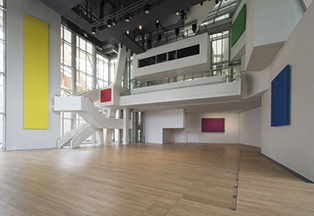
Innenansicht des Neubaus von Frank Gehry. Bild PD
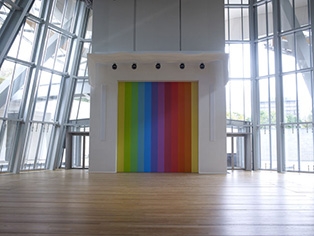
Ausstellung in der Fondation Louis Vuitton: Ellsworth Kelly. Bild PD
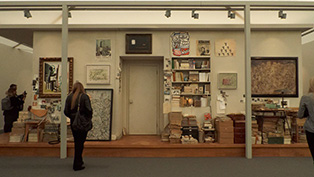
«The Collector - Helly Nahmad at Frieze London 2014»

«The Collector - Helly Nahmad at Frieze London 2014»
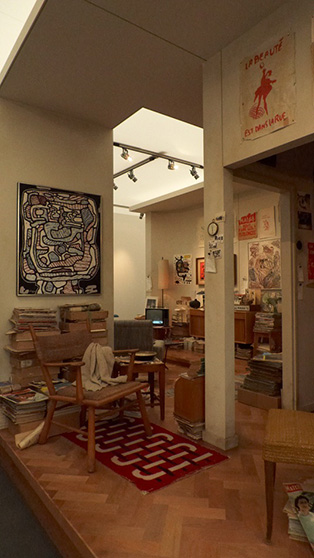
«The Collector - Helly Nahmad at Frieze London 2014»
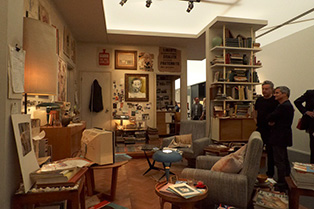
«The Collector - Helly Nahmad at Frieze London 2014», Fotos: © Gisela Torres
«Fondation Louis Vuitton: Ein neues Wahrzeichen für Paris von Frank Gehry»
Die skulpturale Architektur des Pritzkerpreisträgers Frank Gehry erregt Aufsehen und verschafft Paris ein neues Wahrzeichen. Der komplexe Bau gleicht einer kubistischen Skulptur mit zwölf Riesensegeln, aus Paneelen aus opakem Glas zusammengefügt, die sich wie im Wind leicht blähen, als wäre ein Segelschiff gleichzeitig von verschiedenen Seiten zu imaginieren. Gehrys Flaggschiff will den Bilbao-Effekt hinter sich lassen und erntet doch Kritik für den fulminanten Bau.
Im Bois de Boulogne bei Paris wurde die Fondation Louis Vuitton am 27. Oktober 2014 fürs Publikum eröffnet. Als künstlerische Leiterin wurde Suzanne Pagé verpflichtet, die als eine der weltweit angesehensten Kuratorinnen im Bereich der modernen und zeitgenössischen Kunst gilt und langjährig am «Musée d’art moderne de la Ville de Paris» tätig war. Die Sammlungen der Fondation Louis Vuitton sind teilweise unveröffentlicht. Bauherr Bernard Arnault, Besitzer von Louis-Vuitton-Moët-Hennessy, hat laut Schätzungen etwa 100 Millionen Euro investiert. Die Verbindung zwischen Gegenwartskunst und Mode markierte bereits die Zusammenarbeit von Vuitton mit dem Japaner Takashi und seinen seit 2003 für Vuitton gestalteten Handtaschen. Auch im Ladengeschäft Louis Vuitton auf den Champs Elysées hatten bereits Künstler wie James Turrell, Olafur Eliasson und Vanessa Beecroft mitgewirkt.
Architektur als kubistische Skulptur
Augenfälliges Merkmal des Neubaus des 85-jährigen kanadischen Pritzkerpreisträgers Frank Gehry, der seit 1947 in Los Angeles lebt, sind zwölf Riesensegel, die aus 3584 Paneelen aus opakem Glas bestehen. Es erweckt den Eindruck, ein Segelschiff gleichzeitig von verschiedenen Seiten sehen zu können. Hinter einer Brüstung lässt ein Wasserbecken über eine flache Treppe überschwappende Wellen in einen Graben plätschern, der unter dem Bodenniveau des Untergeschosses den Bau umläuft. Überdachte Wege führen am Wasser entlang, teilweise open air. Für seine «Grotto» genannte Promenade hat Lichtkünstler Olafur Eliasson eine Reihe unterschiedlich breiter, dreieckiger Säulen entworfen, die auf zwei Seiten verspiegelt sind, während die dritte ihr gelbes Licht ausstrahlt.
Die Eingangshalle der Fondation Louis Vuitton besticht durch die Materialien der gewählten Farbnuancen: creme am Wandanstrich, beige-rosa für den Steinboden, dunkelbeige für Holztüren, stahlgrau für Träger und Chrom für Geländer. Die für Gehry typische Komplexität der Raumgestaltung wird mit vielfältigen Aus- und Durchblicken erreicht, Balkonen, Mezzaninen, verwinkelten Tragstrukturen, kubischen «Räumen im Raum» sowie einem Glas-Tipi, welches das Restaurant beherbergt.
Von der Eingangshalle führen zwei filigrane Treppen zum Unter- und zu den beiden Obergeschossen. Die «Promenade architecturale» entlang der Aussenseite des Komplexes führt über Treppen zu vier Terrassen auf drei Niveaus mit spektakulären Ausblicken auf den Eiffelturm, die moderne Bürostadt «La Défense» und die Attraktionen des «Jardin d’acclimatation».
Die Eröffnungsausstellung zeigt ausgewählte Werke, neben beispielsweise Altmeister Ellsworth Kelly finden sich junge Künstler wie u.a. Thomas Schütte, Bertrand Lavier, Pierre Huyghe in der Ausstellung. Doch die Hauptattraktion gilt dem fulminanten Bau, auf den die Aufmerksamkeit fokussiert wird. (I.I.)
www.fondationlouisvuitton.fr
Gehry-Ausstellung in der Fondation Louis Vuitton, Paris:
bis 16. März 2015.
im Centre Pompidou bis 26. Januar 2015.
Kataloge:
La Fondation Louis Vuitton. Ed. HYX, Orléans 2014. 160 S., € 55.–.
Frank Gehry. Ed. du Centre Pompidou, Paris 2014. 256 S., € 42.–.
«The Collector – Helly Nahmad at Frieze London 2014»
By Julieta Schildknecht
«New art has always been difficult to understand because it has always sought to replace old habits of thought and perception, old preconceptions and prejudices with new ways of looking at the world and fresh startling insights. But however drastically they may modified the means of expression, the content, or the form of art, composers, artists, and writers of the West have, until now, had the same essential ends – the same essential philosophical orientation – as their predecessors. There is a clear line of development from Aeschylus to Shakespeare to Joyce, from Phidias to Michelangelo to Picasso, and from Monteverdi to Beethoven to Stravinsky». (Leonard B. Meyer, 1967).
Helly Nahmad opened his gallery in London right after finishing his studies at Courtauld, he was 21 in February 1998. The 6’000 sq.ft well established space for impressionist and modern art is famous for showing Nahmads family collection and other masterpieces under consignement: paintings and sculptures by Delacroix, Monet, Picasso, Braque, Matisse, Giacometti, Leger, Modigliani, Bonnard, Miro, Mondrian and Kandinsky to name some artists.
The Nahmad mysterious family is famous for collecting and dealing since the 40’s 19th and 20th century making a fortune in art which is mainly well kept in Geneva. Helly Nahmad’s father and two other uncles started their business acquiring work from artists and traveling to sell work to art buyers all over Europe. Nahmad is today a key name in the art scene all over the world.
Helly Nahmad started as a boy attending auctions and learned much from his uncles Giuseppe and David. Giuseppe Nahmad new the right time to buy and sell works of art and was many times accused of distorting the art market acting as he would run a brockerage firm in the stock market. Today the entire clan may be present in the saleroom to bid together or split their bid.
In 2009 one auctioneer quipped „Sold – to all six of you!“
He likes to stay independent and launches in his gallery or art fairs unusual ways of exhibiting masterpieces.
In 1998 schools would bring their children to the gallery as an alternative to museums to learn that once those artpieces were painted by the artists to sustain their living and today they are purchased either to be hanged at a collectors house or as a valuable investment.
In 2010 the art trader transported out of the family’s Geneva Storage 120 masterpieces to show during three months at Zurich Kunsthaus stating that «It gives us a chance to see what are the collection’s strengths, what are its weaknesses. (…) This is not commercial, but the Swiss are very intelligent, they know that finally everything is for sale, at a price, even in American museums… What few people realise is that we have a huge lending programme, at this moment we have 135 works of art from our collection on loan to various museums shows».
In an interview in Paris in 2011, Helly Nahmad tells Jackie Wullschlager:
«There is such a demand and fashion for art today that people don’t want to wait and see if it’s relevant to the next generation. If you are a collector, then it’s not your raison d’etre but it’s my living. I can’t be wrong. For us, it’s real life and people are reassured by us. It’s about how long you wait. It’s a priceless luxury that we can do that. If I was financially fragile, I might decide not to ignore what’s going on (in contemporary art) because I may be dead before the truth emerges. So money is but your business mustn’t be about money».
The waiting process until a masterpiece is sold requires up to six months of dealing.
This years Frieze Masters highlight was Helly Nahmad Gallery’s hommage to a 60’s collector.
One of the best artist/set designers in England, Robin Brown, built with perfectionist eyes, a collector’s apartment with period furniture and many other 60’s props. He was able to organise within three months a hyper-realist 60’s apartment. The masterpieces were placed around the apartement and on its walls (Dali, Dubuffet, Magritte, Schwitters, Morandi, Twombly, Ernst and de Chirico). It took Robin Brown with his staff, three days to deconstruct the installation and return all objects back.
The entire space was taken by a big installation which daily attracted hundreds of collectors and celebreties. Beyoncé had selfies made in the apartment. Tracey Emin found it a bit sad.
However TV program and chansons which runned the entire time as well as inumerous dynamic conversations about collecting art kept the space alive.
Helly Nahmad wrote a Collectors statement and transformed artwork (objects trouvés) into objects of desire.
An art newspaper the size of The Financial Times with texts by Sir Norman Rosenthal named «The Collector» was published and distributed.
On the cover page, Helly Nahmad wrote:
«The Collector is an exhibition that aims to question the true meaning of collecting art. It is an installation of an imaginary apartment set in Paris in 1968. Our collector is a complex character with a completely unique personality. A passionate, brilliant, eccentric and humble man. Living in post war Milan and then Paris he lives and breathes art. Essentially the contents of his apartment are the result of his desperate search to feel the agony and exstasy of life, through the visual poetry of the greatest artists of his time. Collected one by one over many years the objects in this apartment take us on a remarkable journey into his soul. Like a private journal so intimate and personal, they are a portrait of a man, searching and feeling his way in the dark. This collection represents the journey of one man’s life. The result of a continuous and never ending search for something real.
This exhibition is dedicated to him».
www.hellynahmad.com
www.robinbrowndesign.com

